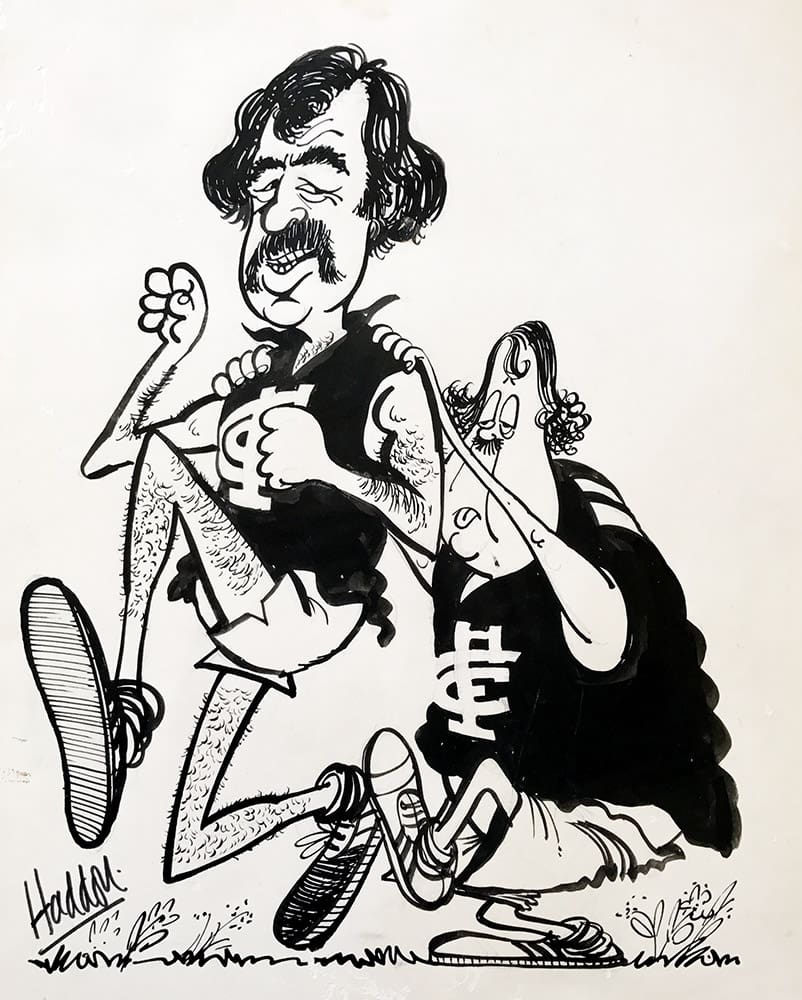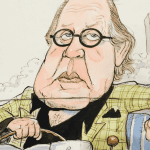PETER COSTER has fine football bloodlines but lacks a yard in pace, so he chose the plodding “Percy” Jones as his companion for a training run with the Old Dark Navy Blues:
IT SEEMED like a good idea at the time. It was 1978 and “Percy” Jones was the slowest player around the Carlton training track at Princes Park. I could just keep up with the lumbering four-time premiership ruckman, who is one of the “legends and larrikins” in Dan Eddy’s book on the Blues, as featured in Sportshounds.
Keeping pace with Jones relied on him being badly hungover from the previous night’s training session at the pub down the tram tracks from Princes Park.
A few cleansing ales were part of the warm-down, but not in the mind of triple Brownlow medallist Ian Stewart, who had just joined Carlton as the “cockroach.”
Stewart was to see out only three matches at Carlton, during which time Jones, who was vice-captain, dropped to the reserves during what Eddy describes as Carlton’s greatest era.
I can now reveal an incident that sits alongside Eddy’s other “untold” stories of the Blues.
Jones’s misfortune was as much to do with what was to be a lung-busting 10 km training run as any loss of form.
I had some form as a Carlton barracker. Three of my grand uncles played for the Blues in the 1890s, something I used as an excuse for changing allegiance from Geelong, where my grandfather played as a rangy wingman and an uncle was a stumpy fullback and captain
I was going to write about the training run from Broadmeadows to Princes Park for a daily column I wrote in The Herald, the Melbourne evening paper.
Jones and I were feeling the effects of the previous evening’s “training” session at Naughton’s pub, a drop kick from the ground.
Jones and I went by bus from Princes Park with the rest of the players the next morning. There was little conversation as we pulled up in the pre-dawn gloom at the Broadmeadows cemetery.
The mist hung like a pall over the gravestones. There were paddocks. There were cows. We were a long way from home.
On the run back, fullback Geoff Southby and rover Greg Towns and a few wild-eyed country recruits were showing the benefits of a more moderate approach to pre-season preparation.
Perc and I were blowing like brewery horses as we staggered back past Pentridge, the old jail with its grim bluestone walls where Ronald Ryan shot warder George Hodson a few years earlier.
Ryan was the last man to be hanged in Victoria and my wife, whose brother had played for Carlton, was an angry university student who hung a banner reading “Hangman Henry” across the running rails during a meeting at the Hamilton Racing Club.
When you think about it, Victoria is a deeply tribal society and football and the fate of Ronald Ryan filled the pages of the newspapers. Premier Sir Henry Bolte was cast as the “hangman.”
The Carlton Football Club was a league powerhouse in those years having won premierships in 1968, 1970 and 1972. The Blues missed in 1978, but won again in 1979 and then back-to back premierships in 1981 and 1982 before more flags in 1987 and 1995.
The Famous Old Dark Blues were invincible. Alex Jesaulenko’s screamer over Collingwood’s “Jerker” Jenkins was the mark of the century.
“Jezza” and Perc often lit up a fag during half-time in big matches. They tried to hide it by sneaking off into the toilet cubicles, but the smoke could be seen curling out from beneath the doors.
The Blue Baggers were a team of characters as well as being the team of the century and I was at Princes Park to witness some of Carlton’s more sophisticated training drills, such as the tractor tyre filled with lumps of bluestone and broken bricks tied to a player with a piece of rope.
The test was how far and how fast you could pull it and no-one pulled it further and faster than Bruce Doull, known as the Flying Doormat as his hair trailed out behind him when his sweatband slipped.
He never said much. If he liked you, you got a slow smile that was as genuine as the game he played.
Jones had more to say, but sometimes it took him a while to say it. One of the pubs he ran with rover “Gags” Gallagher was the “Blush and Stutter” in Carlton. Gallagher was inclined to blush and Jones to stutter.
Here I must admit to a manipulation of the facts, as reported in the Herald column that rainy day. A figure appeared at my shoulder urging me on as Perc panted alongside. I fantasised that the figure was that of the great Czechoslovak runner Emil Zatopek.
But it was only the name of the great man on the T-shirt of Carlton fitness coach Peter Power, who asked me if I “enjoyed” running.
The man must have been a sadist. I couldn’t have lifted a beer as we went past the famous First and Last pub, depending on which way you were going. “Chilled beer”, it promised on the window. I was chilled to the bone and in danger of being run down by trucks carrying squealing pigs to Newmarket, or being sucked in by snorting council cleaning machines as Power pounded on.
“B-b-bugger this,” said Perc as he saw a tram coming down Sydney Road past “Bluestone College”, where George Harris was the prison dentist as well as being the Carlton president. George might have been in there pulling teeth and looking out through the bars when Jones and I hailed the No 19 tram.
We collapsed on board to the astonishment of the early-morning passengers. Some asked Jones for an autograph. Likely Collingwood supporters sneered.

To save Jones from the wrath of the cockroach, I kept the tram trip out of the Herald story, but as it turned out it wouldn’t have made any difference. Ian Stewart was watching the players as they ran into the car park as we got off the tram.
The untold story is that dropping the then three-time premiership ruckman to the reserves was because Jones caught the tram.
The only plus for Perc was that I paid for the tickets.
PETER COSTER is a former editor and foreign correspondent who has covered a range of international sports, including world championship fights and the Olympic Games.




Discussion about this post